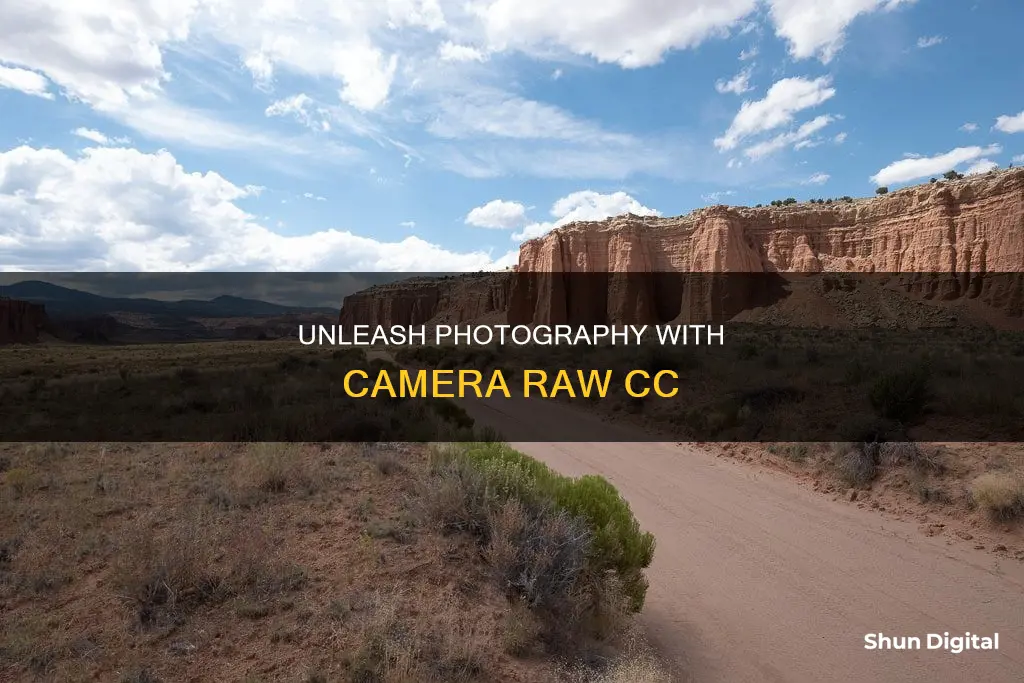
Adobe Camera Raw (ACR) is a tool that lets you import and enhance raw image files. Raw image files are uncompressed digital image files that contain all the information collected by a digital camera. They are like undeveloped films, and they are unique to each camera manufacturer. Camera Raw acts as a decoder, converting raw files into a format that Photoshop can read. It also includes image editing tools that allow you to make adjustments to the raw files, such as white balance, contrast, saturation, and sharpness.
What You'll Learn
- Camera Raw is a plug-in for Photoshop that lets you import and enhance raw image files
- It can also be used to process TIFF and JPEG photos
- Camera Raw files are uncompressed and contain all the information collected by a digital camera
- You can make adjustments to settings like white balance, contrast, saturation, and sharpness
- It is included in the Adobe Creative Cloud Photography package

Camera Raw is a plug-in for Photoshop that lets you import and enhance raw image files
Camera Raw is a powerful plug-in for Photoshop that allows users to import and enhance raw image files. It is a tool that has been used by professional photographers since its release in 2003. Essentially, it acts as a raw image converter, allowing Photoshop to decode and process raw image files.
Raw image files are uncompressed digital image files that contain all the information collected by a digital camera's sensor. They are like undeveloped films, giving photographers full control over the subsequent image processing and correction. With Camera Raw, users can adjust settings like white balance, contrast, saturation, and sharpness to enhance their raw images.
One of the key advantages of using Camera Raw is the ability to preview raw files. It is the only way to truly preview a raw photo, as the image displayed on the camera's LCD screen is merely a JPEG preview. Camera Raw also offers unique adjustment controls that are not available in Photoshop, such as tonal redistribution, superior noise reduction, and sharpening features.
Another benefit of using Camera Raw is that it preserves 16 bits per channel, resulting in higher-quality photos. This helps offset data loss from subsequent image edits in Photoshop. Additionally, Camera Raw saves edits to TIFF and JPEG files within the file itself, while edits to raw files are saved as instructions in a separate "sidecar" file or the Camera Raw database. This ensures that the original raw file remains untouched.
Camera Raw is particularly useful for correcting defects in photos, such as poor contrast, under or overexposure, colour casts, blurriness, geometric distortion, and noise. It also allows users to enhance their photos with special effects like vignettes, grain textures, or tints.
Overall, Camera Raw is an essential tool for photographers who want to get the most out of their raw image files and have more control over their image editing process.
Charging the Black Magic Camera: A Step-by-Step Guide
You may want to see also

It can also be used to process TIFF and JPEG photos
Adobe Camera Raw is a tool that allows users to import and enhance raw image files. It can also be used to process TIFF and JPEG photos. While raw image files are unprocessed and uncompressed, TIFF and JPEG images are typically processed and compressed by the camera. This means that when editing TIFF and JPEG images in Camera Raw, you are editing pixels that have already been processed by the camera.
When you open a TIFF or JPEG image in Camera Raw, you can apply various adjustments such as sharpening the image, reducing noise, correcting lens defects, and retouching. You can also make colour adjustments, including changes to the white balance, tone, and saturation. Once you have finished making adjustments, you can save the image in various formats, including PSD, JPEG, TIFF, or DNG.
One advantage of using Camera Raw to process TIFF and JPEG images is that it allows you to apply adjustments to multiple images simultaneously. This can be useful if you have a set of images taken under the same conditions and want to apply the same set of adjustments to all of them. You can also fine-tune individual shots after applying the initial adjustments.
Another benefit of using Camera Raw is that it gives you more control over the post-processing of your images. With TIFF and JPEG files, the camera has already applied some processing, which limits your ability to modify the image. With Camera Raw, you can make more extensive adjustments to the image without sacrificing quality.
It is important to note that Camera Raw is not a substitute for shooting in raw format. Shooting in raw gives you the most flexibility and control over your images. However, if you are working with TIFF or JPEG files, Camera Raw can still be a powerful tool for enhancing your images and applying adjustments that might not be possible with other editing software.
Leasing Infrared Cameras: Understanding Finance Charges
You may want to see also

Camera Raw files are uncompressed and contain all the information collected by a digital camera
A camera raw file contains unprocessed, uncompressed grayscale picture data from a digital camera's image sensor. This is combined with metadata about how the image was captured. Photoshop's Camera Raw software interprets the camera raw file, using information about the camera and the image's metadata to construct and process a colour image.
The camera raw file can be reprocessed at any time, and the original camera raw data is always preserved. Adjustments are stored as metadata in an accompanying sidecar file, in a database, or in the file itself (in the case of DNG format).
When shooting in JPEG, the camera automatically processes the file to enhance and compress the image. This means that you have little control over how this processing occurs. Shooting in camera raw gives you greater control, as the file is not locked into the processing done by your camera.
Camera raw files always contain the original, unprocessed pixels from the camera. They are much larger than JPEG images and take up more space on your memory card and hard drive. They also take longer to record, so you can't shoot as many in a row as you can with JPEG.
Every camera manufacturer has its own raw file format. For example, Canon raw files are .CR2 or .CR3, while Nikon's are .NEF.
Flying with Fully Charged Camera Batteries: Safe or Not?
You may want to see also

You can make adjustments to settings like white balance, contrast, saturation, and sharpness
Camera Raw is a plug-in for Adobe After Effects and Adobe Photoshop that allows you to import and work with camera raw files. Camera raw files contain unprocessed, uncompressed grayscale picture data from a digital camera's image sensor, along with metadata about how the image was captured.
When you adjust a camera raw image, the original data is preserved. Adjustments are stored as metadata in an accompanying sidecar file, in a database, or in the file itself (in the case of DNG format). This gives you greater flexibility than shooting in JPEG, where the camera automatically processes and compresses the image, limiting your control.
White Balance
The White Balance control in the Photoshop Camera Raw dialog box allows you to correct any colour cast in your image by reflecting the lighting conditions when the photo was taken. You can choose a white balance from the menu, or fine-tune it using the Temperature and Tint adjustments. The Temperature slider adjusts the colour temperature, moving the image colours cooler (bluish) or warmer (yellowish) to compensate for the lighting conditions. The Tint slider fine-tunes the white balance to compensate for any green or magenta tint in the image.
Contrast
The Contrast slider in the Camera Raw dialog box adjusts the midtone contrast of your image. Higher values increase the midtone contrast, while lower values produce an image with less contrast. You can also use the Exposure and Brightness sliders to adjust the brightness or darkness of your image.
Saturation
The Saturation slider in Camera Raw adjusts the colour saturation of the image from -100 (pure monochrome) to +100 (double the saturation). It is recommended to use this slider for removing, rather than adding, colour. Vibrance is a smarter alternative for adding colour, as it only affects dull colours in the image, avoiding flesh tones and preventing skin tones from becoming oversaturated.
Sharpness
The Sharpening section in Camera Raw allows you to adjust the edge definition and clarity of your image. The Amount slider controls the amount of sharpening applied, with higher values increasing the sharpening effect. The Radius slider determines the size of the details that sharpening is applied to. The Detail slider adjusts how much the edge areas are affected by sharpening, bringing out texture and detail. Finally, the Masking slider restricts sharpening to areas near the strongest edges, with a setting of 100 applying sharpening only to the most obvious edges.
Attaching Camera Battery Pack: A Step-by-Step Guide
You may want to see also

It is included in the Adobe Creative Cloud Photography package
Adobe Camera Raw is a tool that allows users to import and enhance raw image files. It is included in the Adobe Creative Cloud Photography package, along with other essential tools like Adobe Photoshop Lightroom and Photoshop. The package is designed to help photographers, both beginners and professionals, develop their style and enhance their images.
The Creative Cloud Photography plan offers tools to edit, transform, and retouch photos. It includes Lightroom for desktop, mobile, and web, as well as Lightroom Classic and Photoshop on desktop and iPad. With these tools, photographers can make basic edits to brightness and contrast, work with presets, and organise their photos across devices.
Adobe Camera Raw is particularly useful for processing and editing raw image files. When shooting in raw format, a camera saves unprocessed, uncompressed image data along with metadata about how the image was captured. This gives photographers greater control over the final image, as they can adjust settings like white balance, tonal range, contrast, colour saturation, and sharpening.
By using the Adobe Creative Cloud Photography package, photographers can take advantage of the powerful raw image processing capabilities of Adobe Camera Raw, along with the editing and organisational features of Lightroom and Photoshop, to enhance their images and develop their unique style.
Olympus Camera Battery Encoding: What's the Deal?
You may want to see also
Frequently asked questions
Camera Raw is a plug-in for Adobe Photoshop that allows users to import and enhance raw image files. It is included with Photoshop and can be opened by selecting "Filter > Camera Raw Filter" in the Photoshop menu.
Camera Raw offers powerful controls for correcting common issues in your photos, such as exposure, colour casts, noise, and more. It also allows for enhancements like vignettes, grain textures, and tints. Additionally, Camera Raw preserves the original raw image file while saving edits as instructions in a separate file, allowing for non-destructive editing.
Camera Raw can process raw, TIFF, and JPEG photos from most digital camera models.
To open a photo in Camera Raw, go to "Filter > Camera Raw Filter" in the Photoshop menu. If you are using Adobe Bridge, you can also open a photo in Camera Raw by selecting "Open in Camera Raw" from the right-click menu.







